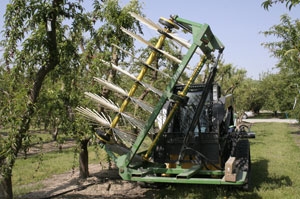
UC researchers are experimenting with a variety of methods that will help farmers reduce the cost of fruit thinning. Peach, nectarine, plum and apple trees typically set a tremendous amount of fruit. The fruit must be thinned considerably to ensure adequate fruit size.
Since employing farmworkers for hand thinning is a major expense for farmers, researchers have been looking for a mechanical alternative.
One such machine being tested this spring is a “drum shaker,” which was recently shipped to the Kearney Agricultural Research and Extension Center from the USDA Agricultural Research Service’s Appalachian Fruit Research Station in West Virginia.
“We took the drum shaker out to several orchards,” said UC staff research associate Becky Phene, who works in collaboration with UC pomology specialist Scott Johnson. “In four locations, we tagged and labeled shoots, then ran the drum shaker through those rows.”
The researchers counted the fruit on the shoots before and after the drum shaker treatment.
“Our findings show a modest removal of fruit at 350 to 400 rpm,” Phene said.
The experiments have shown that a number of factors come into play when using the mechanical thinning device, such as tree structure, age and fruit size.
“The larger, sturdier scaffolds are harder to shake and suffer more shoot damage or shoot removal,” she said. “The younger, more flexible scaffolds appear more capable of reverberating the energy out to more shoots and shake off more fruit. Also, larger fruit tend to have a better removal rate.”